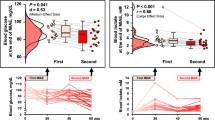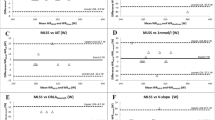Summary
This study was designed to clarify the effects of dietary modifications on the lactate threshold (LT) and on the onset of blood lactate accumulation (OBLA) during progressive incremental exercise. Six healthy males volunteered for the study. Informed consent was obtained from every participant. The following protocol was administered to each subject on three occasions: a 48-h period of mixed dieting (53% carbohydrates, 30% lipids, 17% proteins) preceding the first exercise test, immediately followed by a 48-h period of either a carbohydrate-rich (68% CHO, 23% lipids, 9% proteins) or a fat-rich (19% CHO, 57% lipids, 26% proteins) iso-caloric diet leading to the second exercise and separated from the third test by a 12-days period. Exercise tests were conducted on an electrically-braked ergocycle, and consisted of a progressive incremental maximal exercise. Respiratory parameters were continuously monitored by an automated open circuit sampling system. Exercise blood lactate (LA), free fatty acids (FFA), glucose levels and acid-base balance were determined from venous blood samples obtained through an indwelling brachial catheter. Peak lactate values, workload and performance time were not significantly altered by imposed diets. Furthermore, dietary modifications had no significant effect on LT, OBLA fixed at 4 mmol and ventilatory threshold. Increased pH and FFA mobilization were observed with fat-rich diet, while CHO-rich diet markedly increased the respiratory exchange ratio (R). It is concluded that LT and OBLA are not significantly altered by fat or CHO enrichment of diets.
Similar content being viewed by others
References
Bergström J, Hermansen L, Hultman E (1967) Diet muscle glycogen and physical performance. Acta Physiol Scand 71:140–150
Brozek J, Keys A (1951) The evaluation of leanness-fatness in man: Norms and interrelations. Br J Nutr 5:194–206
Brozek J, Grande F, Anderson JT, Keys A (1963) Densitometric analysis of body composition: Revision of some quantitative assumptions. Ann NY Acad Sci 110:113–140
Costill DL, Thompson H, Roberts E (1973) Fractional utilization of the aerobic capacity during distance running. Med Sci Sports 5:248–252
Davis JA, Vodak P, Wilmore JH, Vodak J, Kurtz P (1976) Anaerobic threshold and maximal aerobic power for three modes of exercise. J Appl Physiol 41:544–550
Farrel PA, Wilmore JH, Coyle EF, Billing JE, Costill DL (1979) Plasma lactate accumulation and distance running performance. Med Sci Sports Exerc 11:338–344
Gollnick PD, Bagly WM, Hodgson DR (1986) Exercise intensity, training, diet, and lactate concentration in muscle and blood. Med Sci Sports Exerc 18(3):334–340
Gutmann I, Wahlefeld AW (1974) In: Berganeyer HU: Methoden der enzymatischen Analyse, 3, Edizione, vol 11. Verlag Chemie, Weinheim, p 1510
Henritze J, Weltman A, Schurrer RL, Barlow K (1985) Effects of training at and above the lactate threshold on the lactate threshold and maximal oxygen uptake. Eur J Appl Physiol 54:84–88
Hughes EF, Turner SC, Brooks JA (1982) Effect of glycogen depletion and pedalling speed on “anaerobic threshold”. J Appl Physiol 52:1598–1607
Hughson RL, Kowalchuk JM (1981) Influence of diet on CO2 production and ventilation in constant-load exercice. Respir Physiol 46:149–160
Hultman E (1971) Muscle glycogen stores and prolonged exercise. In: Shephard RJ (ed) Frontiers of fitness. C C Thomas, Springfield, pp 37–60
Ivy JL, Costill DL, Van Handel PJ, Essig DA, Lower RW (1981) Alteration in the lactate threshold with changes in substrate availability. Int J Sports Med 2:139–142
Jacobs I (1981) Lactate, muscle glycogen and exercise performance in man. Acta Physiol Scand [Supp] 495
Jacobs I, Kaiser P (1982) Lactate in blood mixed skeletal muscle and Ft or St fibers during cycle exercise in man. Acta Physiol Scand 114:461–466
Jacobs I, Sjödin B, Kaiser P, Karlsson J (1981) Onset of blood lactate accumulation after prolonged exercise. Acta Physiol Scand 112:215–217
Jansson E, Kaijser L (1982) Effect of diet on muscle glycogen and blood glucose utilization during a short-term exercise in man. Acta Physiol Scand 115:341–347
Jones NL, Sutton JR, Taylor R, Toews CJ (1977) Effect of pH on cardiorespiratory and metabolic responses to exercise. J Appl Physiol 43:959–964
Kelman GR, Maughan RJ, Williams C (1975) The effect of dietary modifications on blood lactate during exercise. J Physiol 251:34–35
Kindermann W, Simon G, Keul J (1979) The significance of the aerobic-anaerobic transition for the determination of workload intensities during endurance training. Eur J Appl Physiol 42:25–34
Kowalchuk JN (1980) The effect of dietary alterations on respiratory gas exchange during exercise. MSc Thesis University of Waterloo
Kowalchuk JM, Heigenhauser GJF, Jones NL (1984) Effect of pH on metabolic and cardiorespiratory responses during progressive exercise. J Appl Physiol 57:1558–1563
Mader A, Liesen H, Heck H, Philippi H, Rost R, Schurch P, Hollmann W (1976) Zur Beurteilung der sportartspezifischen Ausdauerleistungsfähigkeit im Labor. Sportarzt Sportmed 27:80–88
Mader A, Hollman W (1977) Zur Bedeutung der Stoffwechselleitungsfähigkeit des Eliteruderers im Training und Wettkampf. Leistungssport 9:8–62
Maughan RJ, Poole DC (1981) The effects of a glycogen-loading regimen on the capacity to perform anaerobic exercise. Eur J Appl Physiol 46:211–219
Maughan RJ, Williams C, Campbell DM, Hepburn D (1978) Fat and carbohydrate metabolism during low intensity exercise: Effects of the availability of muscle glycogen. Eur J Appl Physiol 39:7–16
Neary PJ, MacDougall JD, Bachus R, Wenger HA (1985) The relationship between lactate and ventilatory thresholds: coincidental or cause and effect? Eur J Appl Physiol 54:104–108
Noma A, Okabe H, Kita M (1973) A new colorimetric microdetermination of free fatty acids in serum. Clin Chim Acta 43:317–320
Pascale LR, Grossman MJ, Sloan HS, Frankel T (1956) Correlations between thickness of skinfolds and body density in 88 soldiers. Human Biol 28:165–176
Pinelli A (1973) A new colorimetric method for plasma free fatty acid analysis. Clin Chim Acta 44:385–390
Rennie MS, Johnson RH (1974) Effects of an exercise-diet program on metabolic changes with exercise in runners. J Appl Physiol 37:821–825
Saltin B, Hermansen L (1967) Glycogen stores and prolonged severe exercise. In: Blix (ed) Symposia of the Swedish Nutrition Foundation. 5. Nutrition and physical activity. Almquist, Wiksell, Uppsala, pp 32–46
Siggard-Andersen O (1974) The acid-base status of blood. 4th Revised edition. Munksgaard, Copenhagen
Sjödin B, Jacobs I (1981) Onset of blood lactate accumulation and marathon running performance. Int J Sports Med 2:23–26
Sloan AW (1967) Estimation of body fat in young men. J Appl Physiol 23:311–315
Sutton JR, Jones NL, Toews CJ (1981) Effect of pH on muscle glycolysis during exercise. Clin Sci 61:331–338
Wasserman K (1967) Lactate and related acid base and blood gas changes during constant load and graded exercise. Can Med Ass J 96:775–779
Weltman A, Katch VC (1979) Relationship between the onset of metabolic acidosis (anaerobic threshold) and maximal oxygen uptake. J Sports Med 19:133–142
Winer RJ (1971) Statistical principles in experimental design. McGraw Hill, New-York
Yoshida T (1984) Effect of dietary modifications on lactate threshold and onset of blood lactate accumulation during incremental exercise. Eur J Appl Physiol 53:200–205
Yoshida T (1986) Effect of dietary modifications on anaerobic threshold. Sports Med 3:4–9
Yoshida T, Nagata A, Muro M, Takeuchi N, Suda Y (1981) The validity of anaerobic threshold determination by a Douglas bag method compared with arterial blood lactate concentration. Eur J Appl Physiol 46:423–430
Author information
Authors and Affiliations
Additional information
This study was supported by grants from NATO No. 86/ 0435 and FIR, Université du Québec à Trois-Rivières
Rights and permissions
About this article
Cite this article
Quirion, A., Brisson, G.R., Laurencelle, L. et al. Lactate threshold and onset of blood lactate accumulation during incremental exercise after dietary modifications. Europ. J. Appl. Physiol. 57, 192–197 (1988). https://doi.org/10.1007/BF00640662
Accepted:
Issue Date:
DOI: https://doi.org/10.1007/BF00640662




